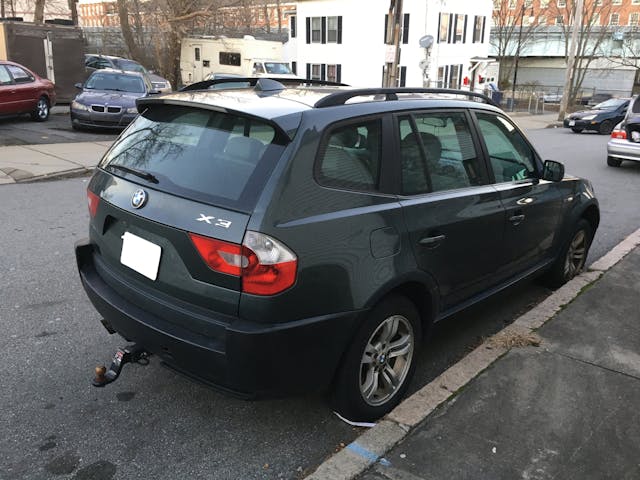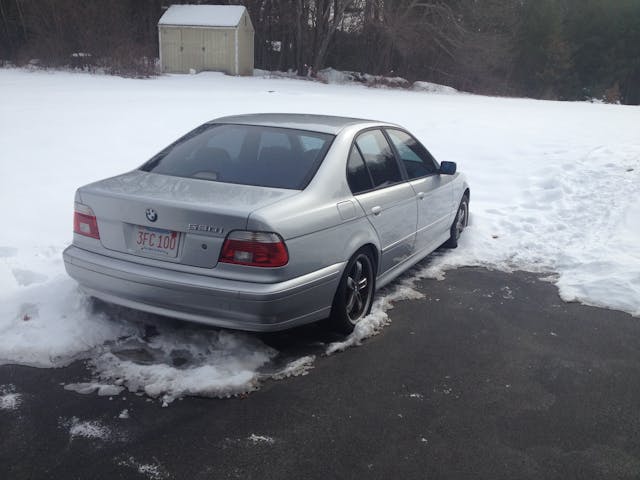Media | Articles
Is it too late to buy myself another car for Christmas? (Part II)

Last week, I described seeing a 2005 BMW X3 six-speed manual with 170,000 miles advertised for $1000 on Facebook Marketplace. The ad said the low price was due to a possible issue in the transfer case or differential.
A few days before Christmas, I drove the hour and a half down to New Bedford, Massachusetts, to look at it. The front body panels were mismatched from a low-cost, do-it-yourself accident repair. Further, the car was incredibly difficult to start, the exhaust was disconnected, most of the dashboard warning lights were on, there was water on the front passenger floor, and the handbrake lever was missing.
The car was unregistered, so I only drove it 200 feet. Whatever issue caused the seller to suspect and highlight the potential transfer-case issue didn’t raise its head in that short trip. There were, however, so many other problems that the transfer case faded into the background like the MacGuffin at the end of a Hitchcock film. Even if I wanted the car—and I wasn’t sure I did—I hadn’t brought a trailer with me, so there was little reason to commit.
So I thought about it.
Whenever I look at a car and am not immediately hit with a slam-dunk “run away” or a “shut up and take my money,” I’ll come home, sit at the laptop, and list the pros and cons. The main positives? The X3 was cheap, it was available, it ran and drove, it could be trailered home for maybe a hundred bucks in U-Haul fees and diesel fuel, and it could sit in my driveway instead of occupying precious garage space. Finally—and this was the biggie—could generate a winter’s worth of Hack Mechanic columns.
Marketplace
Buy and sell classics with confidence
The cons, once enumerated, clearly outweighed the pros. The big one was how the mismatched body panels put a hard cap on resale value—an important consideration given how I have zero lust for an X3, rare manual transmission notwithstanding. I saw the car only as something to keep my hands busy, to use as a winter beater, and to maybe make a little money on at the end of winter. The hard starting was also a concern. A dead vehicle in my driveway, one not easily moved into the garage for work, was wholly unappealing. Even the fact that several of the tires were low from sitting buttressed the feeling—along with registration, taxes, insurance, inspection, and the bare minimum of needed repairs, my thousand-dollar purchase would likely double in cost before I could begin to use it as daily transportation.
Plus, as I looked further on Facebook Marketplace, I began to see more X3s and X5s between $1000 and $2500. While some were even less appealing (e.g., “needs engine”), other ads reported only dashboard warning-light issues. The fact that the car in New Bedford was a rare manual example wasn’t enough to trump both its other needs and the numerous other available choices.

Eventually, I began to look at the New Bedford car from a more subtle, yet realistic, angle. As I’ve written, I’ve never owned a new car. Instead, I have for decades daily-driven well-used BMWs that are near the bottom of their depreciation curve. I do this because I like the cars and want the blend of performance, handling, and comfort they offer, but I don’t want the financial load of either an outright purchase or a monthly car payment. Two things have made this possible—I can fix cars myself, and for 35 years, I had a very short commute. (Okay, three things—the third being an incredibly understanding wife). These days, I work from home, and since my wife’s car is a Honda Fit with only 60,000 miles on the clock, we do own something reliable. So it’s easy to continue my old habits.
In general, fully depreciated, high-mileage BMWs advertised for astonishingly low prices usually have a combination of issues. Even if the body is great and the interior presents well, the Check Engine Light (CEL), ABS, and traction control lights are often on. CEL issues on a car that generally runs well can be as trivial as an occasional misfire from a single cylinder (usually due to a bad stick coil) or a dead oxygen sensor. They can also be something like a dirty catalytic converter, or an evaporative system leak that’s difficult to find. Other common maintenance issues are oil leaks, power steering leaks, and worn front-end bushings.
Individually, none of those are a big deal. They’re typically well within the skills of a backyard mechanic, but they can easily result in a repair quote for thousands of dollars. At that point, “estimate shock” often causes the owner to bail out of the car.
From a reliability standpoint, I’ve written multiple articles about “The Big Seven,” the problems most likely to strand a car. Years back, when I first came up with that list, it was mainly targeted at the stuff that would likely make a vintage car die on a road trip. These days, it applies pretty well to modern daily drivers—just remove “clutch hydraulics” and substitute “crankshaft position sensor” for “ignition issues.”
It’s been nearly six years since I bought my high-mileage 2003 530i on a blustery, 10-degree Presidents Day weekend when I had little to do but pound on Craigslist for bargains. The car was literally embedded in a snowbank in the seller’s driveway. He insisted that it had “an electrical problem,” because when he tried to jump-start the dead battery, it made “that clicking sound.” I showed up with a fully-charged battery, dropped it in, turned the key, and the car fired up instantly. When we shoveled it out of the snowbank, a test drive revealed only flat-spotted tires and a check engine light, later traced to a simple rotted vacuum line.
I’ve been daily-driving the car ever since, and true to “The Big Seven,” the only strand-me issues have been a weak fuel pump and a bad voltage regulator. Although the car hadn’t had any cooling system issues, BMWs built in the last 30-ish years are notorious for the use of plastic in the cooling system (the radiator tanks, expansion tank, thermostat housing, hose ends, and water pump impeller are all plastic). If any of these components crack, they can cause catastrophic coolant loss, and unless you stop the car immediately, the engine will quickly overheat and crack its cylinder head(s).
When I found that several cooling system components on the 530i still wore their original 2003 manufacturer’s date stamp, it was clear that I was tempting fate. So two summers ago, I bit the bullet and dropped around $500 for new OEM cooling system components. While no one can make any guarantees about the reliability of any 200,000-mile car, I feel pretty confident jumping in the 530i to do things like, well, drive 90 minutes in winter to look at a thousand-dollar X3.

And that gets to the heart of the matter. Even if I dragged that New Bedford X3 home and addressed its problems, would I really then de-insure a reliable and reasonably well-sorted 530i and slap its plates on a highly suspect X3 for the winter simply because the SUV has all-wheel drive and the 530i doesn’t?
No. I would not.
Don’t you love it when you think things through until it’s clear you’ve made a rational decision?
Even so, are who we are. My answer at that point wasn’t, “I wouldn’t touch this needy pig with a ten-foot torque wrench.” It was, “Okay, so maybe not $1000. Wonder what he’d take for it?”
I sent the seller a couple of texts—one before Christmas, one a few days after—using language like “What’s your availability for me to come down there with a trailer and see if we can make something happen?” I got no response to either.
That’s fine. These things have a way of working out. One door closes, another one opens. You never know what the Automotive Powers That Be might dangle in front of you next.

Of course, it could go the other way. TAPTB might say, “We were going to dangle the rust-free, running E-Type for $5000, but he passed on the X3, so screw him.”
Somehow, though, I suspect those guys are a fair bunch. Not unduly sadistic. They might note that I’ve kept folks entertained for decades, writing for outlets like this one. At which point the response would probably be something like, “We were going to dangle the rust-free, running Opel GT for $4000, but he passed on the X3, so screw him.”
I can live with that.
***
Rob’s latest book, The Best Of The Hack Mechanic™: 35 years of hacks, kluges, and assorted automotive mayhem is available on Amazon here. His other seven books are available here on Amazon, or you can order personally-inscribed copies from Rob’s website, www.robsiegel.com.



One thing in particular would have had me running from that X3, especially given the possible transmission issue: the tow hitch ball receiver on the rear.
To be fair, I added a small Class 1 1.25-inch tow hitch to my daily-driver Volvo sedan, just so I could add a bicycle carrier to get my mountain bike to the trailhead. But I’d never stress the car by towing anything of serious weight behind it.
The ball receiver combined with transmission issues makes me worry that the X3’s seller has been towing various trailers, ignoring the vehicle’s measly factory-designated towing capacity.
Rob, here is an idea, the last car you looked at, has a relative new front clip (no salt damage) and what appears to be four good factory wheels. For $1,000 you could take it home and pull all the good bits off and sell them on flea bay or just as a lot to a local non-manufacturer repair shop, of which New England is ate up with as most of you Yankees don’t drive or support American or its companies. You could triple your money. Just a thought.
Just run away from it…. Too many others to choose from.